Chess Notes
Edward Winter
When contacting us by e-mail, correspondents are asked to include their name and full postal address and, when providing information, to quote exact book and magazine sources. The word ‘chess’ needs to appear in the subject-line or in the message itself.
| First column | << previous | Archives [153] | next >> | Current column |
10404. Rovner v Guldin
From page 49 of Adventure in Chess by Assiac (London, 1951):

Neishtadt gave the venue as Leningrad, not Moscow, on page 111 of Improve Your Chess Tactics (Alkmaar, 2011) and, as shown below, on page 71 of Шахматный практикум (Moscow, 1980):
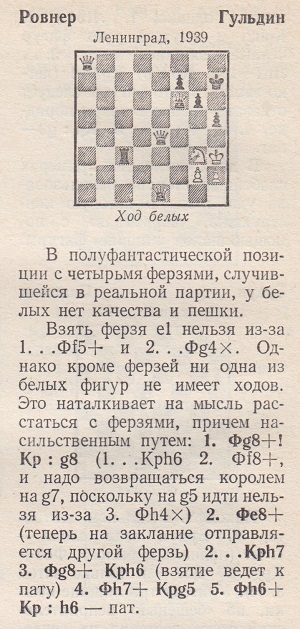
Some of the earlier moves were included on page 141 of the Schweizerische Schachzeitung, August-September 1945:
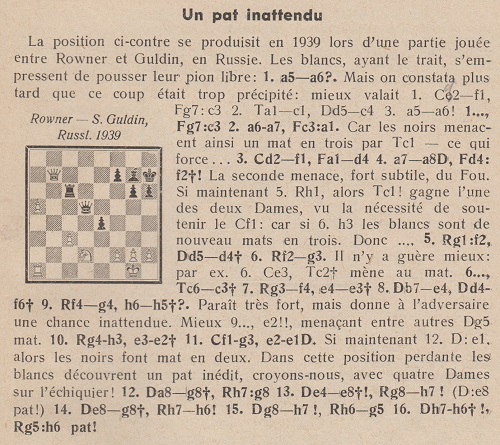
Earlier publications are sought. The complete game (headed ‘USSR, 1938’) is in the ‘curio.pgn’ file on Tim Krabbé’s website.
10405. Suzana Makai (C.N. 10399)
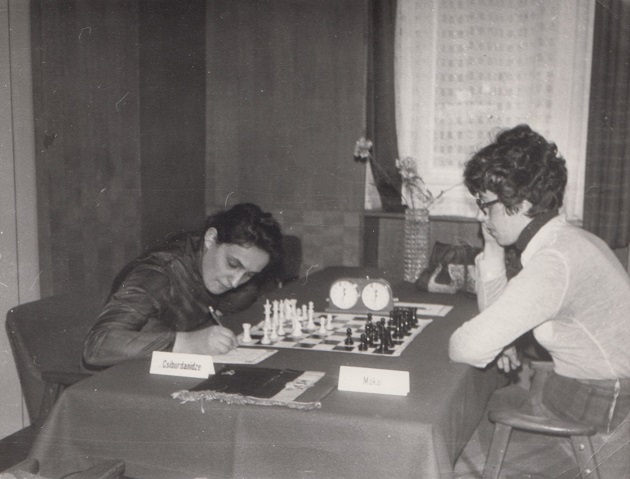
Maia Chiburdanidze and Suzana Makai
Jan Hessel (Rättvik, Sweden) reminds us of the book Harminc év a sakktábla mellett by Zoltán Makai (Nagyvárad, 2010), a 239-page tribute to Suzana/Zsuzsa Makai compiled by her brother.

Page 226 has this game-score
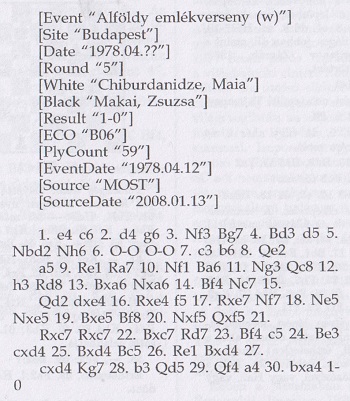
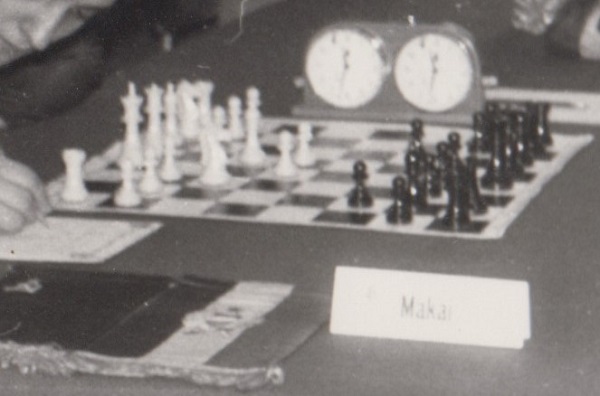
Our copy of the book is inscribed by the compiler:
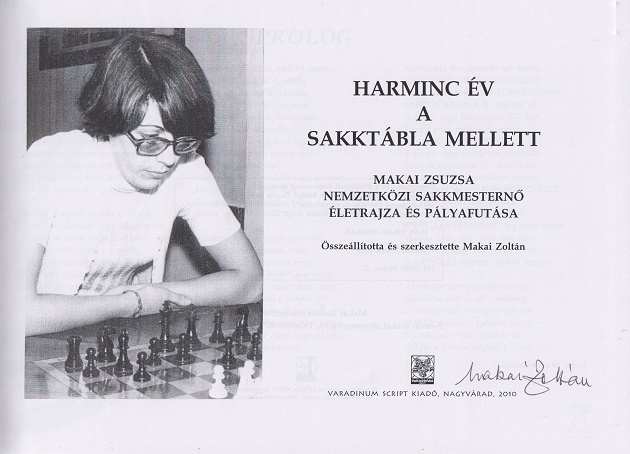
10406. Rare queen sacrifices
An addition to the list in The Fox Enigma (‘positions in which a player moved his queen to KKt6 (i.e. g6 or g3) when the opponent had three unmoved pawns before his castled king’) comes from page 177 of the November 1945 Schweizerische Schachzeitung, at the end of a theoretical article by Paul Müller:
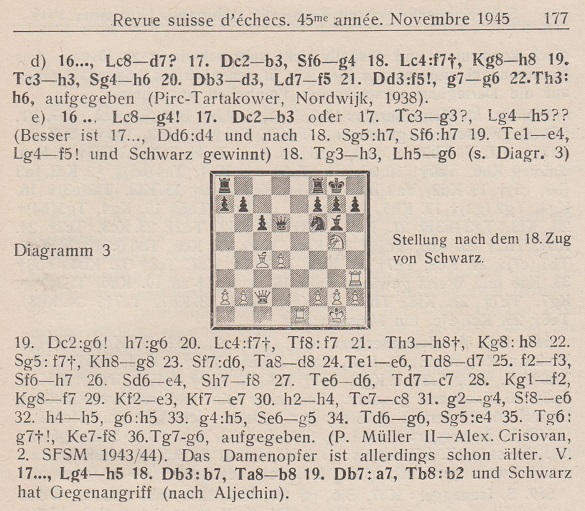
Paul Müller – Alex Crisovan
Swiss correspondence championship, 1943-44
Queen’s Gambit Declined
1 d4 d5 2 c4 e6 3 Nc3 Nf6 4 Bg5 Nbd7 5 e3 Be7 6 Nf3 O-O 7 Rc1 c6 8 Bd3 dxc4 9 Bxc4 Nd5 10 Bxe7 Qxe7 11 O-O Nxc3 12 Rxc3 e5 13 Qc2 exd4 14 exd4 Nf6 15 Re1 Qd6 16 Ng5 Bg4 17 Rg3 Bh5 18 Rh3 Bg6 19 Qxg6 hxg6 20 Bxf7+ Rxf7 21 Rh8+ Kxh8 22 Nxf7+ Kg8 23 Nxd6 Rd8 24 Re6 Rd7 25 f3 Nh7 26 Ne4 Nf8 27 Rd6 Rc7 28 Kf2 Kf7 29 Ke3 Ke7 30 h4 Rc8 31 g4 Ne6 32 h5 gxh5 33 gxh5 Ng5 34 Rg6 Nxe4 35 Rxg7+ Kf8 36 Rg6 Resigns.
The result of the game was reported on page 137 of the August-September 1944 Schweizerische Schachzeitung, and the complete crosstable was on page 19 of the February 1945 issue.
As shown in Wade v Bennett, the queen sacrifice in this line was already familiar.
10407. A quote attributed to Bogoljubow and Chigorin (C.N.s 5063 & 9647)
From page 33 of the December 1944 Chess Review, in an article by I.A. Horowitz:
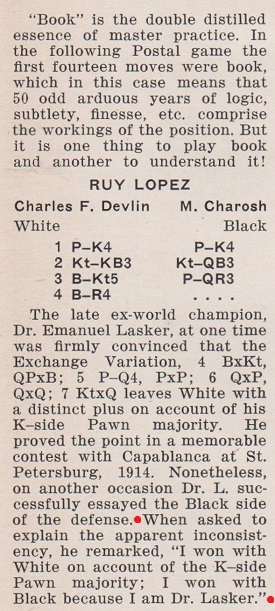
10408. Paradoxes regarding Réti
A paragraph on page 367 of José Raúl Capablanca A Chess Biography by M.A. Sánchez (Jefferson, 2015):

It is dispiriting to see ‘allegedly wrote (per Chessquotes.com but unconfirmed)’ in any outlet, and especially in a McFarland book and in connection with a familiar, easily-documented remark. Below is page 169 of Tartakower’s Die hypermoderne Schachpartie (Vienna, 1924):
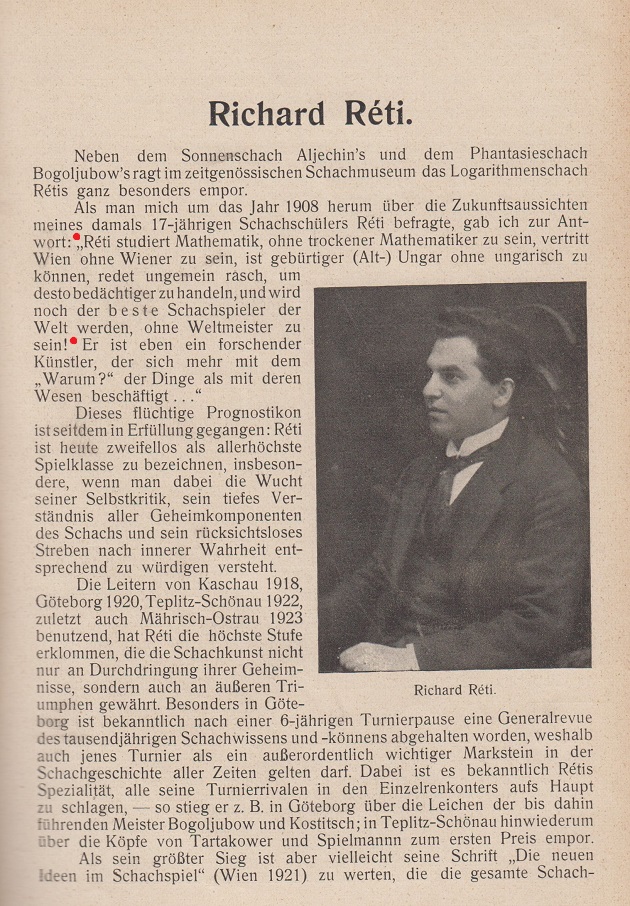
A good translation of the passage about the Réti paradoxes was on page 45 of the February 1952 Chess Review:
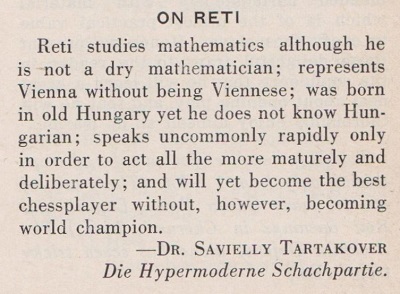
An awful translation, by Jared Becker, is on page 141 of The Hypermodern Game of Chess (Milford, 2015), a book criticized in C.N. 9701:
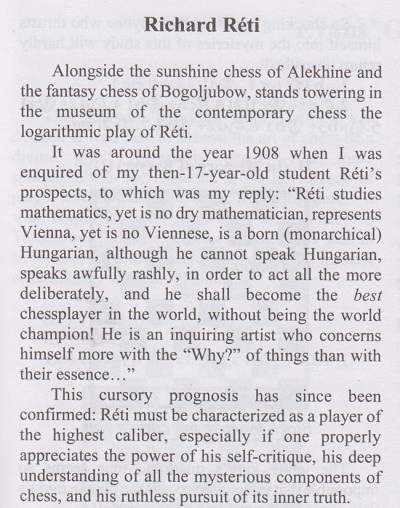
10409. An alleged contradiction by Réti
An item on page 428 of CHESS, 14 July 1937:

To help them ‘work it out’, readers of CHESS were given neither the source nor the exact text of Réti’s comments.
From page 182 of Masters of the Chess Board (London, 1933), in the ‘My System of Opening’ section:

However, the original German text, on page 330 of Die Meister des Schachbretts (Mährisch-Ostrau, 1930), is entirely logical:
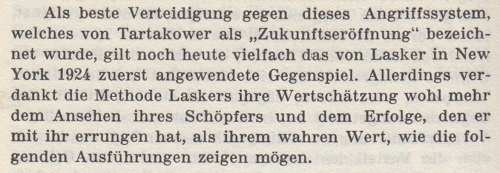
Réti’s observation may be paraphrased as follows: Lasker’s line (1 Nf3 d5 2 c4 c6 3 b3 Bf5) is often considered, still today, the best defence, but its reputation is due more to Lasker’s standing than to its true value.
10410. More Lasker games
Thomas Niessen (Aachen, Germany) sends four games from simultaneous exhibitions which Emanuel Lasker published in his column in the Vossische Zeitung in 1919:
Emanuel Lasker – Dr F.
Neuchâtel, 10 May 1919
Ruy López
1 e4 e5 2 Nf3 Nc6 3 Bb5 a6 4 Ba4 Nf6 5 O-O b5 6 Bb3 d6 7 c3 Be7 8 d4 Bg4 9 Be3 O-O 10 h3 Bh5 11 Nbd2 h6 12 Rc1 Na5 13 Bc2 c6 14 g4 Bg6 15 dxe5 dxe5 16 Nxe5 Bd6 17 Nxg6 fxg6 18 f4 Nh7 19 e5 Bc7 20 Bxg6 Qh4 21 Kh2
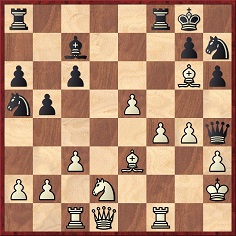
21...Ng5 22 Rf3 Nxf3+ 23 Nxf3 Qe7 24 Bb1 g5 25 fxg5 Bxe5+ 26 Kg2 Nc4 27 Bf2 hxg5 28 Qe2 Rae8
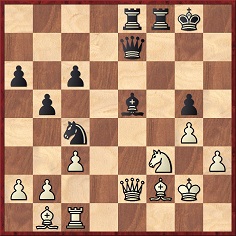
29 Re1 Qf7 30 Nxg5 Qf4 31 Nf3 Bxc3 32 Qd3 Qxf3+ 33 Qxf3 Rxf3 34 Rxe8+ Kf7 35 Kxf3 Nd2+ 36 Ke2 Kxe8 37 Bg6+ Resigns.
Source: Vossische Zeitung, 25 May 1919, page 15.
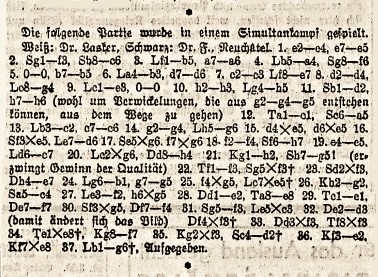
Emanuel Lasker – N.N.
Berne, 1919
Ruy López
1 e4 e5 2 Nf3 Nc6 3 Bb5 Nf6 4 O-O Nxe4 5 d4 Be7 6 Qe2 d5 7 Nxe5 Bd7 8 Nxd7 Qxd7 9 Re1 a6 10 Bxc6 bxc6 11 Nd2 Ng5
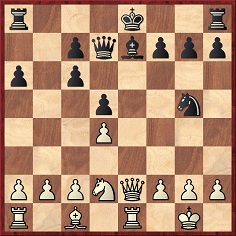
12 Nc4 Ne6 13 Ne5 Qd6 14 f4 O-O 15 c3 Bf6 16 Ng4 Nxf4 17 Bxf4 Qxf4 18 Rf1 Qd6 19 Nxf6+ gxf6 20 Qh5 Rae8 21 Rf3 Qe6 22 Rh3 Qe4 23 Qh6 Resigns.
Source: Vossische Zeitung, 1 June 1919, page 10.
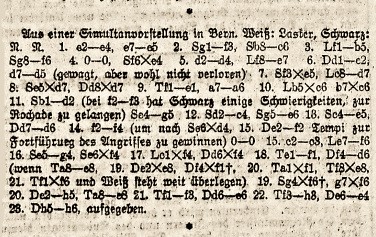
Emanuel Lasker – Allies
Stuttgart, August 1919
Ruy López
1 e4 e5 2 Nf3 Nc6 3 Bb5 a6 4 Ba4 Nf6 5 O-O Nxe4 6 d4 b5 7 Bb3 d5 8 dxe5 Be6 9 c3 Be7 10 Nbd2 O-O 11 Nd4 Nxd4 12 cxd4 Nxd2 13 Bxd2 c5 14 Be3 c4 15 Bc2 Qd7 16 f4 f5 17 Qe2 a5 18 Kh1 b4 19 Rf2 a4

20 Rg1 b3 21 axb3 axb3 22 Bb1 g6 23 h3 h5 24 g4 hxg4 25 hxg4 Kg7 26 g5 Rh8+ 27 Rh2 Rxh2+ 28 Kxh2 Rh8+ 29 Kg3 Qd8 30 Qg2 Rh5 31 Rh1 Qh8 32 Rxh5 Qxh5 33 Qf3 Qxf3+ 34 Kxf3 Bb4 Adjourned.
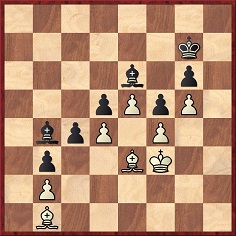
Source: Vossische Zeitung, 24 August 1919, page 17.
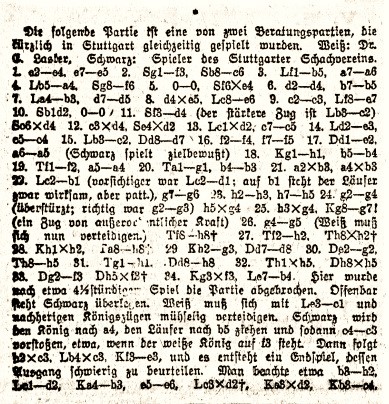

Emanuel Lasker – N.N.
Denmark, 1919
Ruy López
1 e4 e5 2 Nf3 Nc6 3 Bb5 Nf6 4 O-O Nxe4 5 d4 d5 6 Nxe5 Bd7 7 Nxd7 Qxd7 8 Re1 Be7 9 Qe2 Nd6 10 Bxc6 bxc6 11 Nd2 Nf5
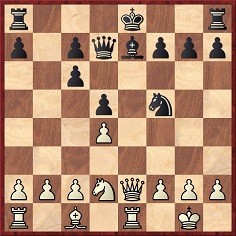
12 Qg4 O-O 13 Rxe7 Qxe7 14 Qxf5 Qe1+ 15 Nf1 Rfe8
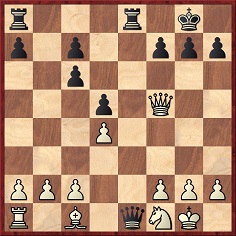
16 Bh6 Resigns.
Source: Vossische Zeitung, 28 December 1919, page 17.
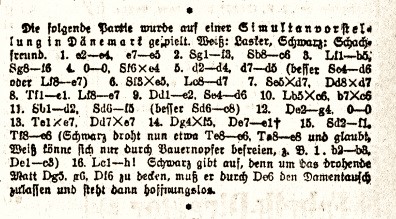
Regarding the first game, we add a report on Lasker’s visit to Neuchâtel from page 96 of the June-July 1919 Schweizerische Schachzeitung:
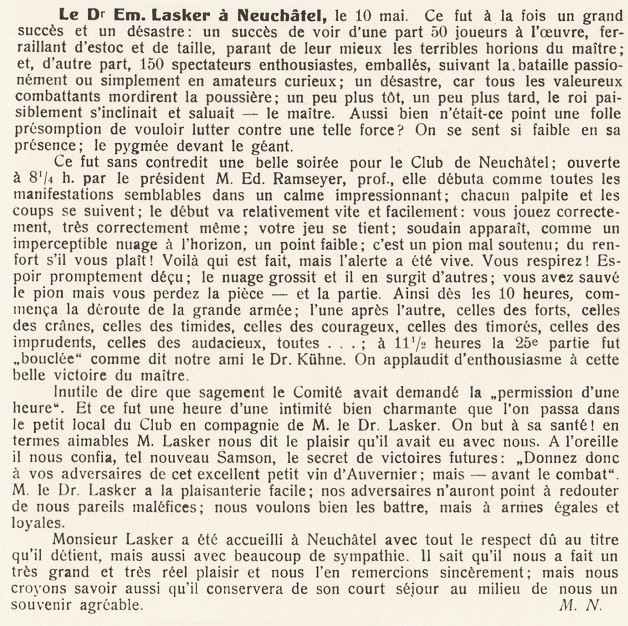
10411. Keres move by move
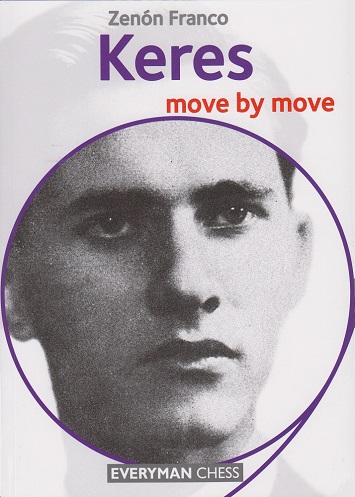
Keres move by move by Zenón Franco (London, 2017) is the latest addition to our list of nearly 30 books about Keres.
Question: how many of the earlier works are mentioned in Franco’s bibliography (page 6)? Answer: none.
10412. The Staunton-Morphy affair
A number of chess authors, and especially American and British ones in the twentieth century, could not, or would not, treat the Staunton-Morphy affair even-handedly. The passage below, written by Fred Reinfeld, is a bombastic example from what may be termed, in shorthand, the ‘pro-Morphy camp’:
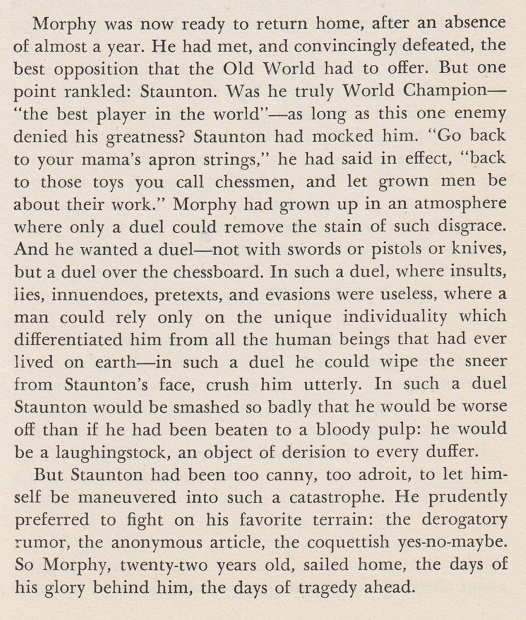
Source: page 65 of Reinfeld’s book The Great Chess Masters and Their Games (New York, 1952 and 1960). The text was on pages 71-72 of the UK edition, The Human Side of Chess (London, 1953).
10413. Capablanca at AVRO, 1938
Quiz question: how many games did Capablanca lose in Amsterdam at the AVRO tournament of 1938?
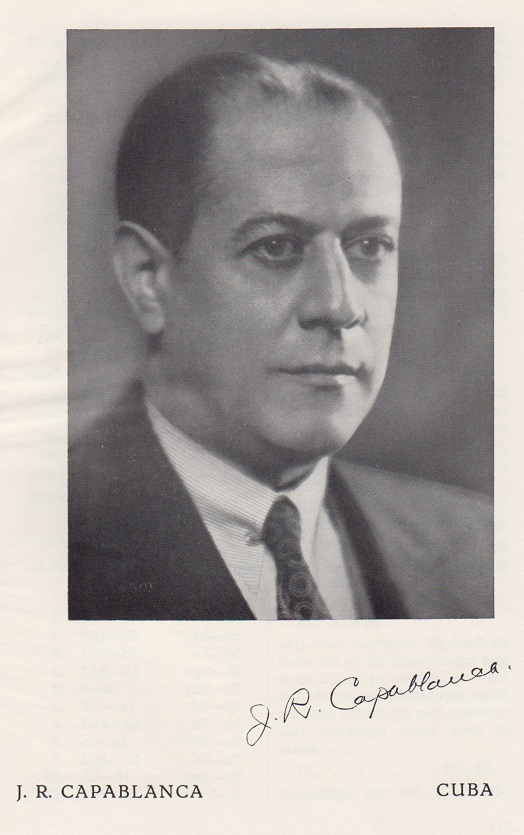
This portrait comes from opposite page 112 of Analysen van A.V.R.O.’s wereld-schaak-tournooi by M. Euwe (Amsterdam, 1938). It is one of several tournament books which show that the Cuban’s losses were as follows:
- v Keres, sixth round, 14 November 1938, in Haarlem;
- v Alekhine, ninth round, 19 November 1938, in Arnhem;
- v Botvinnik, eleventh round, 22 November 1938, in Rotterdam;
- v Euwe, fourteenth round, 27 November 1938, in Amsterdam.
A list of dates and venues is on pages 299-300 of the October 1938 Tijdschrift van den Koninklijken Nederlandschen Schaakbond:
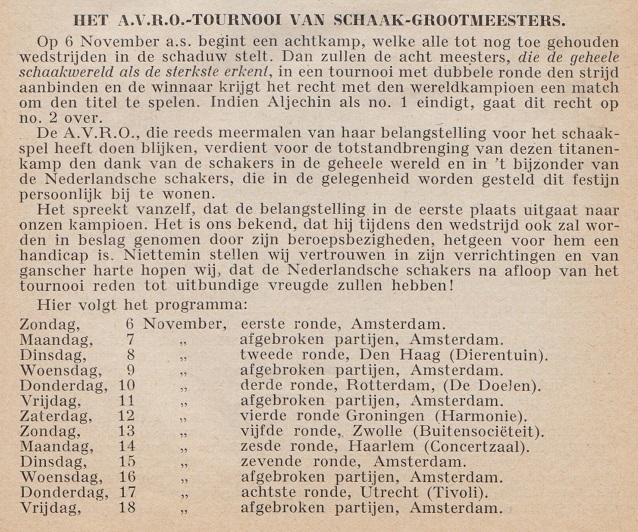
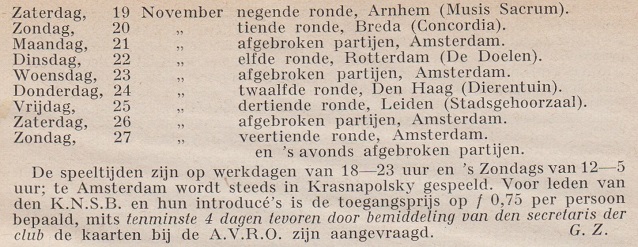
The answer to the quiz question is thus that Capablanca lost one game in Amsterdam, against Euwe, but it is often misstated that the other three defeats also occurred in the Dutch capital. For instance:

Chess Strategy for the Tournament Player by L. Alburt and S. Palatnik (New York, 2000), page 190

Keres move by move by Z. Franco (London, 2017), page 94

Das Schachgenie Aljechin by I. and W. Linder (Berlin, 1992), page 251
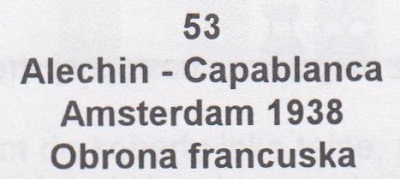
Aleksander Alechin by K. Pytel (Warsaw, undated), page 150
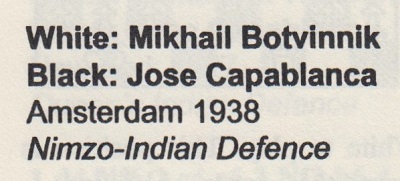
The Sunday Times Book of Chess by R. Keene (Aylesbeare, 2005), page 30

Mikhail Botvinnik by A. Soltis (Jefferson, 2014), page 111.
10414. The first modern grading system
In the ‘Rating Systems’ entry on pages 271-272 of Harry Golombek’s The Encyclopedia of Chess (London, 1977) William Hartston wrote:

Although the Ingo system is mentioned in many chess reference books, and especially German ones, it is nowadays all but forgotten.
From page 255 of CHESS, Easter 1966:
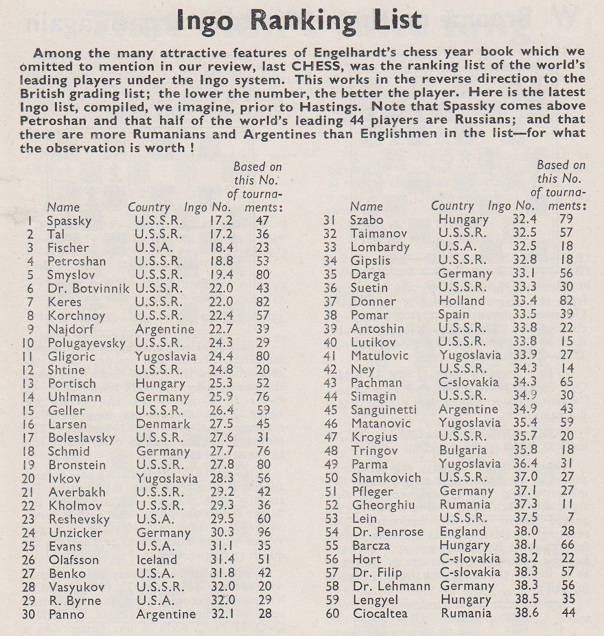
Below is the feature mentioned by CHESS, on pages 94-96 of Schach-Taschen-Jahrbuch 1966 edited by Herbert Engelhardt (Berlin-Frohnau, 1966):

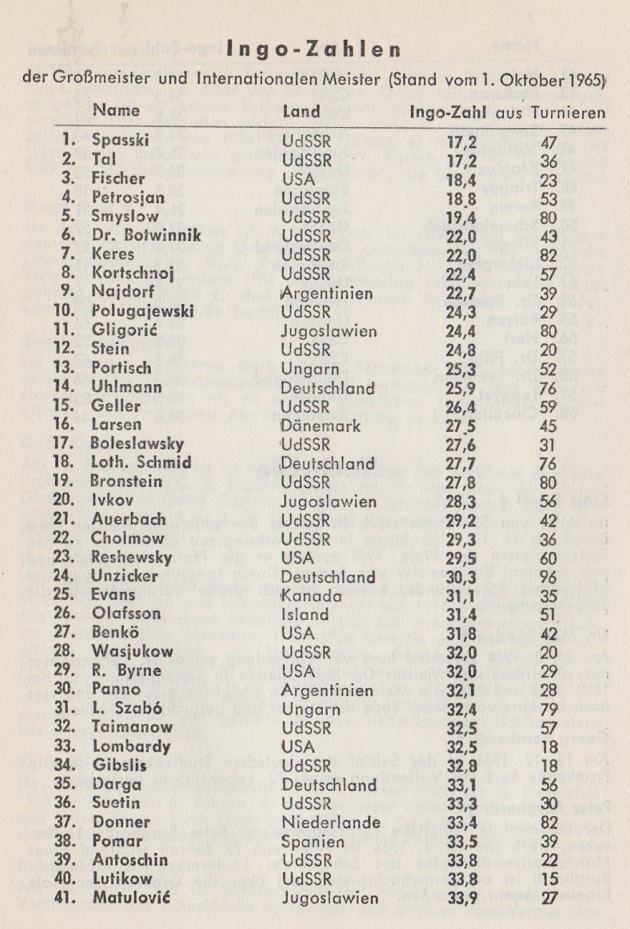
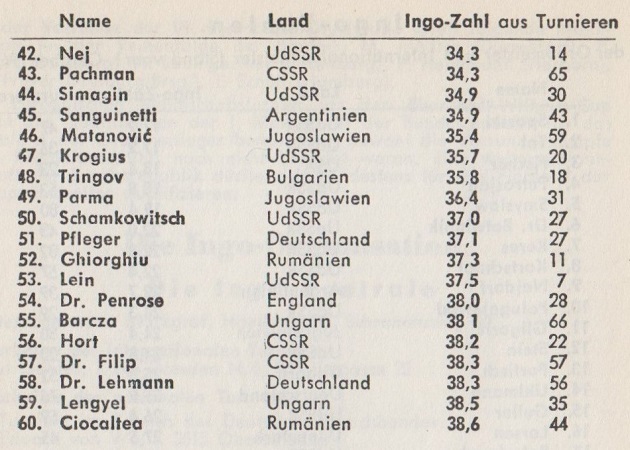
The Ingo system was also referred to briefly in a series of articles entitled ‘The International Chess Federation Rating System’ by Arpad E. Elo in CHESS, July 1973 (pages 293-296), August 1973 (pages 328-330) and October 1973 (pages 19-21). See too pages 16 and 143-144 of Elo’s book The Rating of Chessplayers, Past and Present (London, 1978).
In a list of bibliographical references on pages 295-296
of the July 1973 CHESS Elo gave ‘Hesslinger [sic];
Ingo System; Bayrischen [sic] Schachnachrichten
April 1948’. On pages 143-144 of his book Elo wrote: ‘The
Ingo System, designed by Anton Hoesslinger of Ingolstadt,
Germany, was described in Bayerische Schacht [sic],
1948, and by Herbert Englehardt [sic] (Englehardt [sic]
1951).’
The absence of Hößlinger’s name from the various German-language features is to be noted. The Ingo system was introduced in a series of articles in the Bayerische Schachnachrichten: April 1948, page 14; May 1948, page 19; June 1948, page 21 and page 22; July 1948, page 26.
We also present the article ‘Das Ingo-System’, in the Schach-Taschen-Jahrbuch 1951 edited by Herbert Engelhardt (Berlin-Frohnau, 1951), on pages 105, 106, 107, 108 and 109. It was followed by these rankings on pages 109-111:
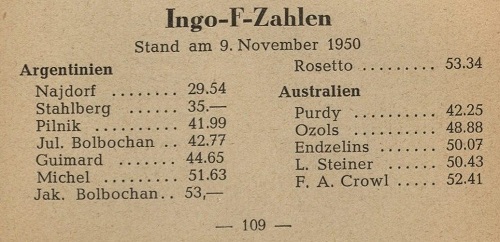
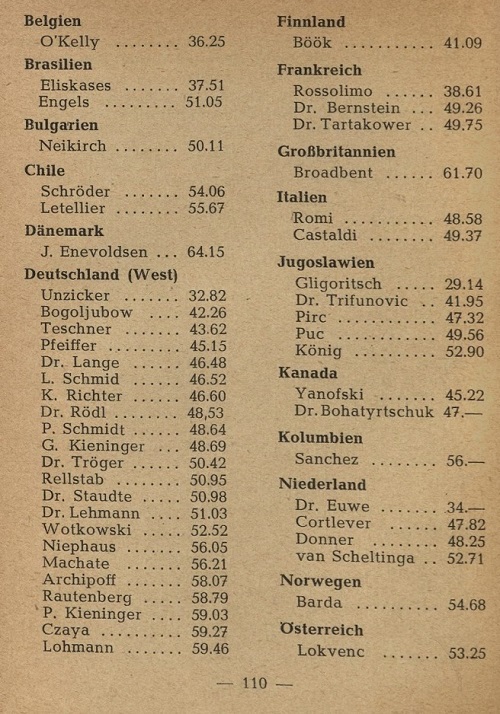
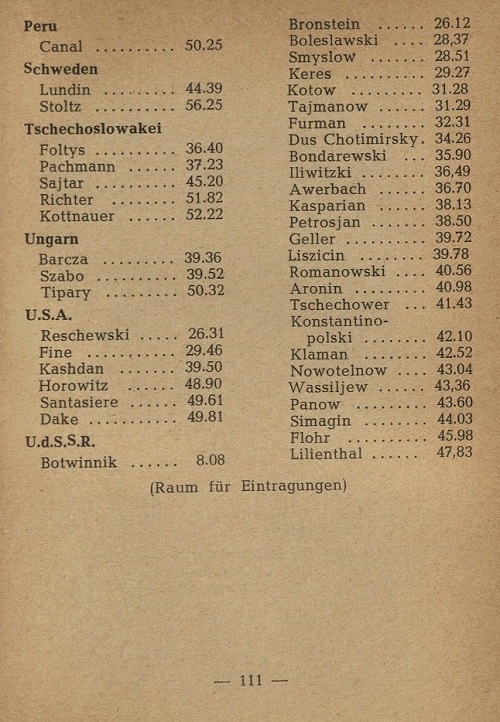
Acknowledgement for the articles in the Bayerische Schachnachrichten and the Schach-Taschen-Jahrbuch 1951: the Cleveland Public Library.
Mention may also be made of ‘Problems of Rating and BCF/INGO Grading’ by Professor H. Schreiner on pages 110-111 of the BCM, March 1991. See too Chess Ratings and Titles.
Finally, the obituary of Anton Hößlinger on the inside front cover of Schach-Echo, 20 January 1960:

10415. Winning a won game (C.N.s 2424 & 5349)
So far, the earliest known first-hand occurrence of the saying ‘Nothing is harder than to win a won game’ is on page 9 of Schach-Aphorismen und Reminiscenzen by A. Albin (Hanover, 1899): ‘Nichts ist schwerer als eine gewonnene Partie – zu gewinnen.’ It received the page to itself:
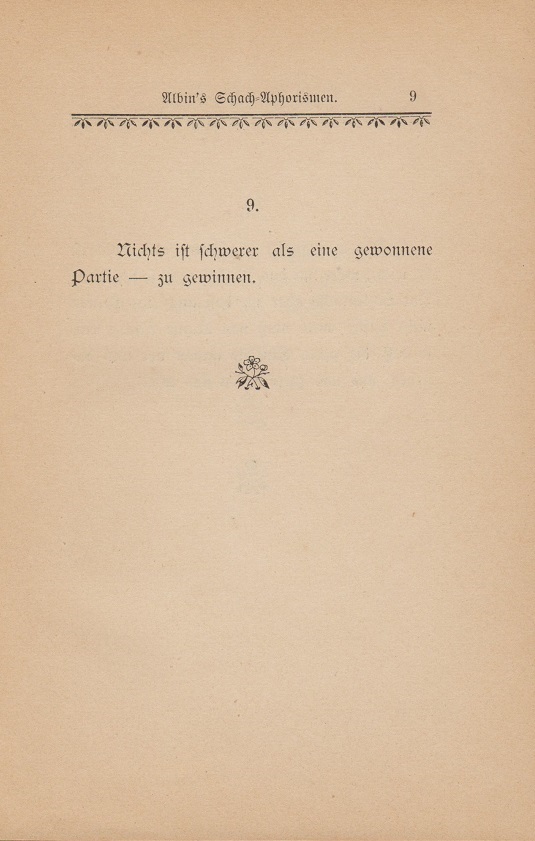
The English version was on page 220 of Checkmate, July 1903, in a feature entitled ‘Albin’s Aphorisms’, whereas the previous year (November 1902, page 30) the Canadian magazine had referred to ‘Tarrasch’s well-known saying that nothing is harder than to win a “won game”’.
As mentioned in C.N. 2424 (see page 392 of A Chess Omnibus), the maxim has been attributed to a number of writers. They include Lasker, as shown by page 179 of Master Chess by Lodewijk Prins (London, 1950):

10416. A statement by Alekhine? (C.N.s 2104, 3896, 3898 & 9029)
The reference by Prins to Alekhine in the previous item is relevant to a matter discussed in a number of C.N. items.
Prins had also written on page 127:
‘Remember the saying that to win one game from Alekhine he had to be beaten thrice: once in the opening, once in the middle game and once in the end game.’
For the suggestion that Alekhine made the remark about himself no reliable source has been found. There are only the unsubstantiated assertions of Larry Evans.
10417. Books on the endings
‘No book on end-games to date has been much more than a collection of abstruse artificialities ...’
Source: CHESS, 14 April 1939, page 308.
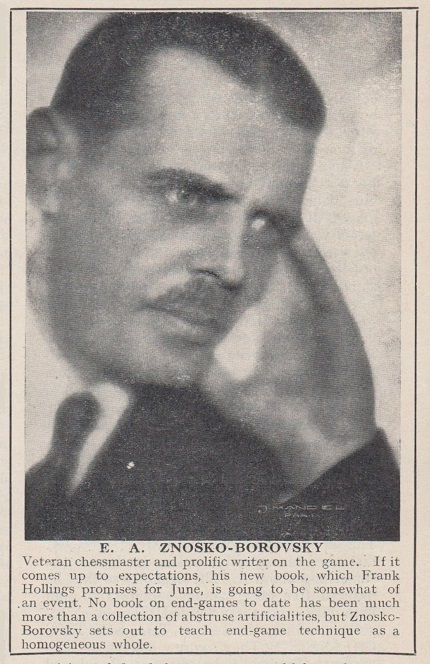
10418. ‘The Greatest Tragedy in Chess History’
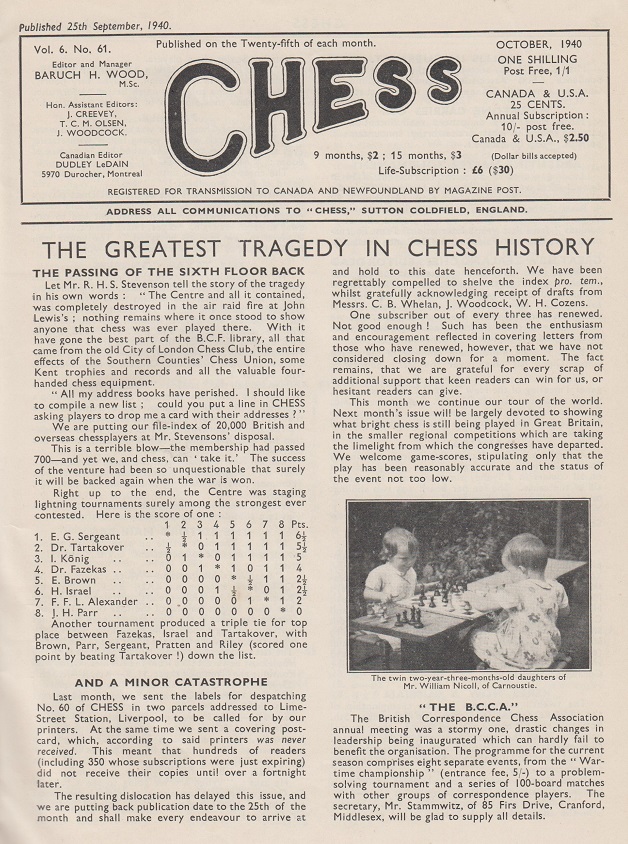
A photograph of the bomb damage (from page 19 of CHESS, November 1940) is in Chess: Hitler and Nazi Germany.
10419. From former times (C.N. 10163)
Another cartoon from CHESS (page 50 of the December 1939 issue):
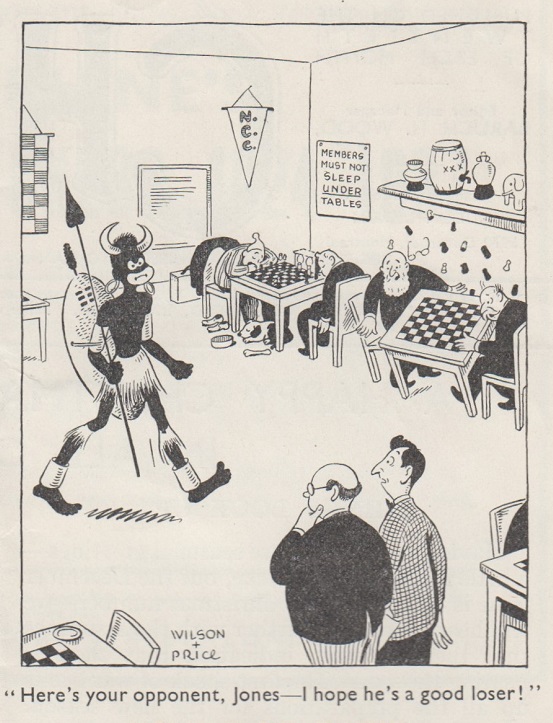
10420. Memory
Further information is sought on this memory event (page 107 of the April 1885 International Chess Magazine):
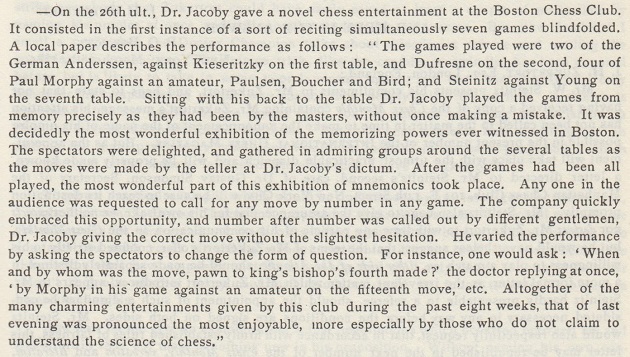
10421. Capablanca v the Allies
Stéphane Pilawski (Hannut, Belgium) refers to a consultation game on pages 22-24 of Capablanca’s My Chess Career (London, 1920) and on page 103 of The Unknown Capablanca by David Hooper and Dale Brandreth (London, 1975):

Position after 35 bxc5
‘Both books mention that at move 35, recapturing White’s pawn on c5 would be of little use to Black because after 35...Bxc5 36 Rf4 Rxf4 37 Bxc5 Qe8 38 gxf4 White would win easily. However, 35...Bxc5 36 Rf4 Rxf4 37 Bxc5 (Bxf4 is better) 37...Qf5 would win the exchange for Black, after which White suddenly stands much worse. Consequently, after 35...Bxc5 it is better for White to exchange bishops by 36 Bxc5, and if 36...Rxc5, 37 Rxh5 wins for White.’
Mr Pilawski also comments on the discrepancy regarding the players’ names in the two books, and below are the relevant pages:
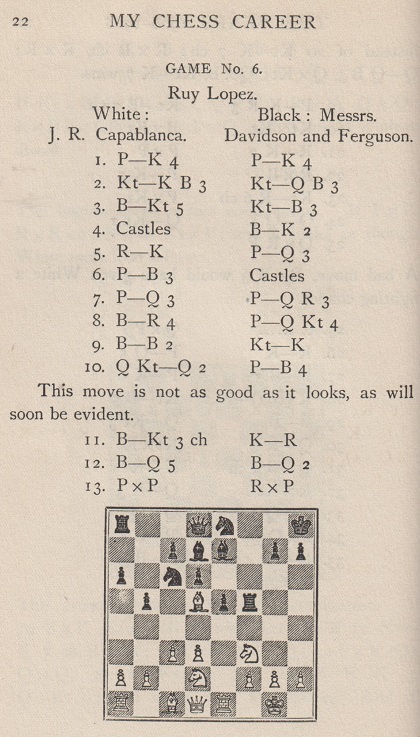
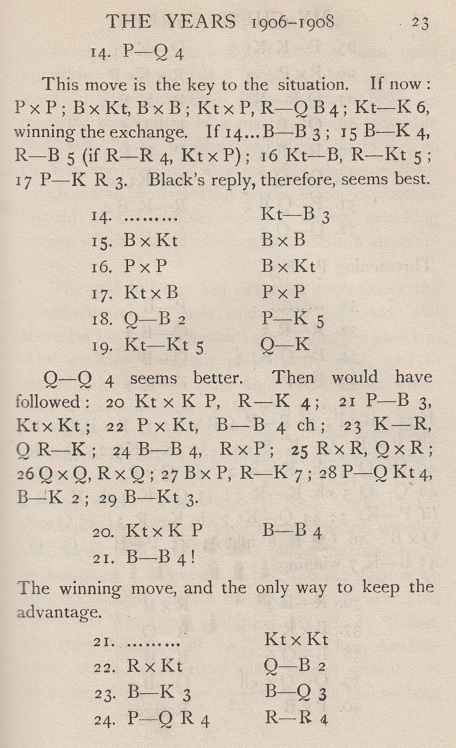
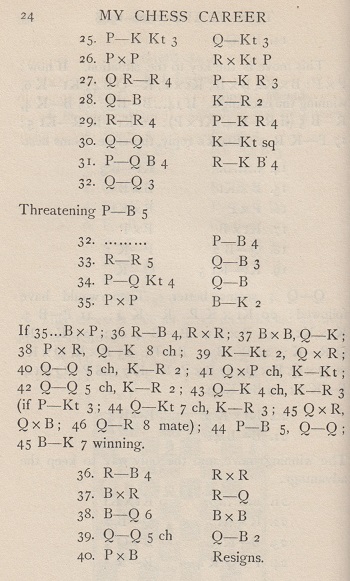

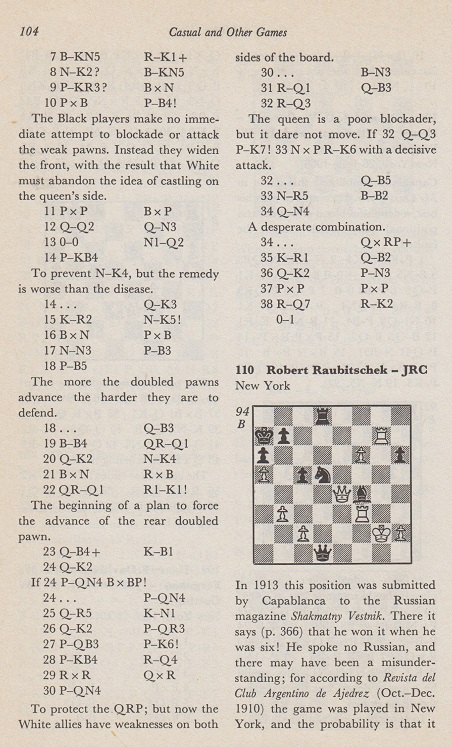
Hooper and Brandreth subsequently issued an errata list which stated concerning game 108 that Curring should read Cutting. That amendment was incorporated into the second, revised edition of The Unknown Capablanca, published by Dover Publications, Inc., New York in 1993:

In My Chess Career Capablanca did not indicate that he had a consultation partner. Nor was reference made to Réti as an ally in a 1914 game against Kaufmann and Fähndrich; we commented on the matter on page 267 of the June 1986 BCM after an earlier item in the Quotes & Queries column (March 1986, page 122) had mentioned both that game and the Ruy López game under discussion here (with, in the latter case, the spelling ‘Currington’).
My Chess Career gave no particulars about the venue and date of the Ruy López game. The introduction to the relevant chapter, on page 14 (page numbers vary in other editions):

The index (page 211) had ‘J.R.C. – Davidson and Ferguson, 1907’. The Unknown Capablanca, in contrast, gave a specific date (28 June 1908), while, as also shown above, the second game involving the same players was headed ‘New York, June 1908 (?)’. The sources for the games were specified as follows on page 200:
Various editions of My Chess Career showed little rigour. On page 40 of a version ‘newly edited and revised by Lyndon Laird’ (Corsicana, 1994) the game had the heading ‘New York, 1906-1908’, whereas the date in the game index (page 237) was 1906. A 1937 translation of Capablanca’s book published in Yugoslavia had 1907 and the spelling ‘Fergson’. There are also Russian and Italian translations – published long after The Unknown Capablanca – which give the date as ‘1906 or 1907’.
As usual, the editions of Capablanca’s games by Rogelio Caparrós (Yorklyn, 1991, Barcelona, 1993 and Dallas, 1994) contributed nothing except confusion. Despite specifying that his source for the two games was The Unknown Capablanca, Caparrós put forward a specific date for the second game, 29 June 1908, without explanation. Although in both headings ‘Cutting’ was the spelling used, this was abbreviated in the index to ‘Cur’.
About that player we can offer no information, but the names of both H. Davidson and R.W. Ferguson appeared in an earlier report, on page 35 of the February 1907 American Chess Bulletin:

10422. When in doubt ...
From page 34 of the Chess Weekly, 4 July 1908:
‘[Bird] was the man that made P-KR4 famous, his sovereign counsel being “when in doubt, play your KRP two squares, sir”.’
Of course, P-KB4 was meant (see Black’s tenth move in the accompanying game):
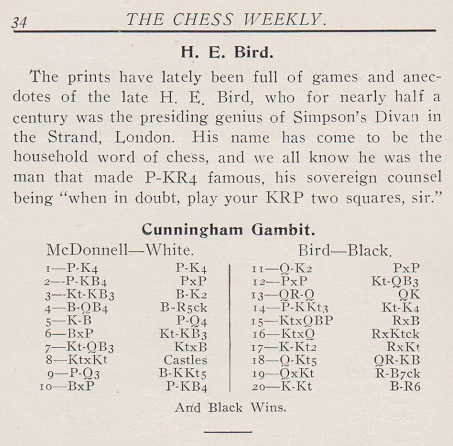
The conclusion of that MacDonnell v Bird game had been given, with more particulars, on page 218 of the March 1889 Chess Monthly:
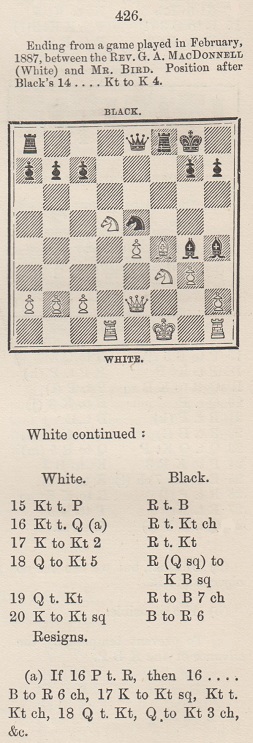
10423. Simultaneous displays by Morphy (C.N.s 6424 & 6496)
A question in C.N.s 6424 and 6496 concerned the largest number of opponents faced by Morphy in simultaneous exhibitions. The figures are relatively small, but can the matter be put beyond doubt?
One claim concerning Morphy (in the period after his match with Anderssen) is quoted below without comment:
‘He confined himself to simultaneous displays, playing 20, 30 and even 40 people at once ...’
Source: page 274 of Keene On Chess by R. Keene (New York, 1999). The identical wording re-appeared on page 275 of Complete Book of Beginning Chess by R. Keene (New York, 2003).
10424. An Alekhine letter
From page 113 of CHESS, May 1941:
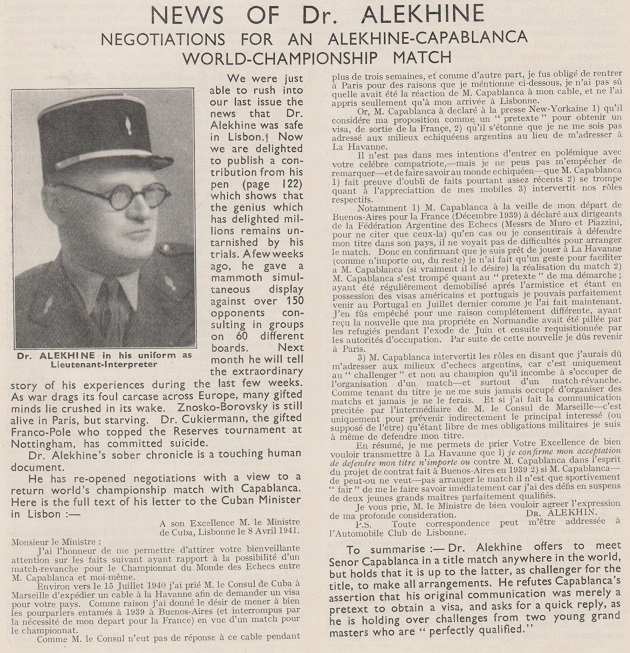
The letter was referred to on page 656 of the 1998 Skinner/Verhoeven book on Alekhine.
10425. Indian Openings
In C.N. 10058 Martin Sims (Upper Hutt, New Zealand) pointed out, regarding Indian Openings, Réti’s statement on page 253 of Die Meister des Schachbretts (Mährisch-Ostrau, 1930) that Kmoch had proposed a set of terms which included Altindisch for an opening with no fianchetto:

However, Mr Sims now draws attention to a footnote by Kmoch on page 33 of Die Kunst der Verteidigung (various editions – the book was first published in 1927):

The term here was not Altindisch but Halbindisch.
10426. Kmoch on Lasker
From page 67 of CHESS, February 1941, in a tribute to Emanuel Lasker by W.H. Cozens:
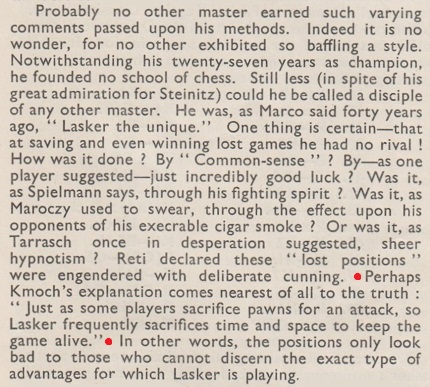
The highlighted remark attributed to Kmoch deserves further scrutiny:
‘Just as some players sacrifice pawns for an attack, so Lasker frequently sacrifices time and space to keep the game alive.’
10427. A cartoon by Cozens
A favourite theme of chess cartoons is the game’s imagined paramountcy.
Firemen were featured in C.N.s 8927, 8943 and 9007, and below is a drawing by W.H. Cozens from page 77 of the February 1941 CHESS:

10428. Mihail Marin on the world championship
Russell Miller (Vancouver, WA, USA) notes a remark by Mihail Marin on page 82 of the Spring 2017 issue of the American Chess Magazine:
‘For 11 years Lasker avoided any new challenge to his title. He only abandoned his ivory tower in 1907 when he defeated Frank Marshall rather convincingly. He also scored victories by a large margin against Tarrasch (!) in 1908 and 1916 and David Janowsky in 1909 and 1910.’
How can anyone write an eight-page history of the world chess championship without knowing that Lasker’s matches against Janowsky in 1909 and Tarrasch in 1916 were not for the title?
Marin’s article (pages 78-85) is one of the worst of its kind that we have seen, a feebly-written job lot of common knowledge and common misconceptions.
10429. Multiple sacrifices
The positions discussed in C.N.s 10397 and 10402 (K. Bayer) and C.N. 6646 (E. Mason) both appeared on page 43 of Chess Review, February 1953, in a column by Bruce Hayden:

10430. The Rou manuscript
Concerning the Rou manuscript (see A Chess Whodunit and, in particular, the reference to the Craftsman, which published a paper entitled ‘A Short Essay on the Game of Chess’, with the signature R.), Robert John McCrary (Columbia, SC, USA) notes an item on page 7 of the 16 January 1881 edition of the Philadelphia Times:

10431. Insatiable futility
From page 34 of Chess Pieces by Norman Knight (London, 1949):

The quotation had appeared on page 30 of the Observer 31 October 1937:
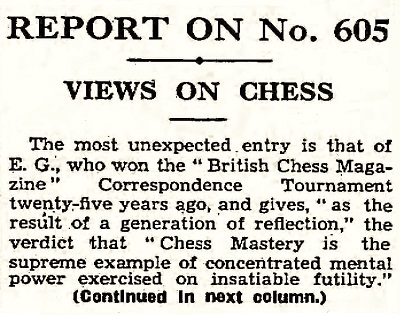
For all the entries which Brian Harley published in his ‘Views on Chess’ competition, see C.N. 7148.
As shown in the BCM in 1912 (e.g. on page 368 of the September issue, from which the photograph below is taken), ‘E.G.’, the winner of the correspondence tournament, was the Reverend Evan Griffiths:

Page 52 of Brighton Chess by Brian Denman (Hove, 1994) stated that ‘he lived to the age of 80 and died as Canon E. Griffiths in 1956’, but we note that page 14 of the Sussex Express & County Herald (Lewes edition) of 2 April 1954 recorded his death, aged 79, at the All Saints Rectory, Lewes on 29 March 1954. The newspaper’s report on his funeral (pages 1 and 7 of the 9 April 1954 Lewes edition) listed among those present ‘Mrs G. Self (Sussex Chess Association)’.
10432. Emanuel Lasker in the Netherlands
In C.N.s 10396 and 10410 Thomas Niessen (Aachen, Germany) presented a number of forgotten games played by Emanuel Lasker in simultaneous exhibitions. Many more have now been discovered by our correspondent and are given below with his commentary in italics.
‘In The Hague on 23 January 1920 Lasker and Capablanca signed a draft agreement for a world title match, and that evening Lasker began a tour of the Netherlands which lasted until mid-February. Several games from his simultaneous displays were republished in K. Whyld’s The Collected Games of Emanuel Lasker (Nottingham, 1998) and in volumes 7 and 9 of the Quarterly for Chess History, but many more can be presented here, from the Delpher website.
At the second display, in Leiden on 26 January 1920, Lasker won 23 games and drew four. Two games were published in De Telegraaf, 28 January 1920 (morning edition, page 3) and the Haagsche Courant, 29 January 1920.’
van Rijnswou – Emanuel Lasker
Leiden, 26 January 1920
Ruy López
1 e4 e5 2 Nf3 Nc6 3 Bb5 Bc5 4 O–O Nge7 5 c3 O–O 6 d4 exd4 7 cxd4 Bb6 8 Be3 d5 9 Nbd2 Bg4 10 e5 Nxd4 11 Bxd4 Bxd4 12 Qc1 Bb6 13 Rd1 c6 14 Bd3 Ng6 15 Bxg6 fxg6 16 h3 Be6
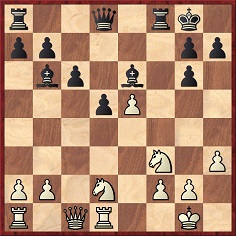
17 Ne4 dxe4 18 Rxd8 Raxd8 19 Ng5 Rxf2 20 Kh2 Bd5 21 Qc3 h6 22 Nxe4 Bxe4 23 Qc4+ Bd5 24 Qg4 Rxg2+ 25 White resigns.
Emanuel Lasker – B. Vles
Leiden, 26 January 1920
Queen’s Gambit Declined
1 d4 d5 2 Nf3 Nf6 3 c4 e6 4 Bg5 Nbd7 5 e3 Be7 6 Nc3 O–O 7 Rc1 c6 8 Bd3 dxc4 9 Bxc4 Qa5 10 O–O e5 11 Re1
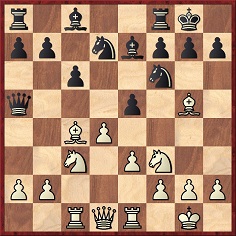
11...Nb6 12 Nxe5 Nxc4 13 Bxf6 Nxb2 14 Nc4 Nxd1 15 Nxa5 Bb4 16 Rexd1 Bxa5 17 Bh4 Be6 18 a3 Bb3 19 Rd2 b5 20 Be7 Rfe8 21 Bc5 Bxc3 22 Rxc3 Bd5 23 f3 a5 24 Kf2 f5 25 h3 Re6 26 Re2 Rae8 27 Re1 Rb8 28 Rb1 Rbe8 29 Bb6 a4 30 Bc5 g6 31 Re1 Rf6 32 Ke2 Rfe6 33 Kd2 Kg7 34 Ke2 f4 35 Kf2 fxe3+ 36 Rcxe3 Rxe3 37 Rxe3 Rxe3 38 Kxe3 Drawn.
‘On 31 January 1920 Lasker gave a display in the VAS (Vereenigd Amsterdamsch Schaakgenootschap). Two more games from the event were published in De Telegraaf, 7 February 1920 (evening edition, page 6). Although this source does not mention the event, it can be identified from the list of players and openings in De Telegraaf, 2 February 1920 (evening edition, page 10).’
Emanuel Lasker – H. van Hartingsvelt
Amsterdam, 31 January 1920
French Defence
1 e4 e6 2 d4 d5 3 Nc3 Nf6 4 Bg5 Be7 5 e5 Nfd7 6 h4 a6 7 Qg4 h5 8 Qf4 c5 9 dxc5 Nc6 10 Nf3 f6 11 exf6 gxf6 12 Bd3 Nde5 13 O–O–O fxg5 14 hxg5 Nxd3+ 15 Rxd3 Rf8 16 Qg3 h4 17 Qg4 Qc7 18 Rxh4 Bd7 19 Qh5+ Kd8 20 Qg6 Ne5 21 Qg7 Nxd3+ 22 cxd3 Qxc5 23 d4 Qd6 24 Ne5 Kc7 25 f4 Rg8 26 Qh7 Raf8 27 g3 Be8 28 Rh6 Kb8 29 Kb1
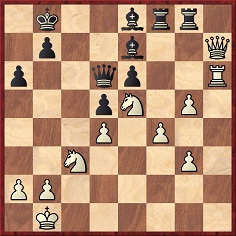
29...Bxg5 30 fxg5 Rxg5 31 g4 Rxe5 32 dxe5 Qxe5 33 Qe7 Rf1+ 34 Kc2
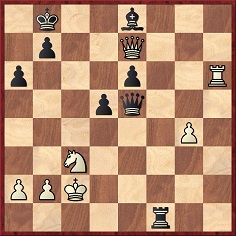
34...Ba4+ 35 Nxa4 Qe2+ 36 Kb3 Rf3+ 37 Nc3 Qc4+ 38 Ka3 Rxc3+ 39 b3 Rxb3+ 40 axb3 Qc1+ 41 Ka4 Qxh6 42 g5 Qg6 Drawn.
Emanuel Lasker – J. Perlmutter
Amsterdam, 31 January 1920
Queen’s Gambit Declined
1 d4 d5 2 Nf3 Nf6 3 c4 e6 4 Bg5 h6 5 Bh4 dxc4 6 e3 b5 7 a4 c6 8 axb5 Bb4+ 9 Nbd2 cxb5 10 Be2 Bb7 11 O–O a6 12 Ne5 O–O 13 Bf3 Bd5 14 h3 g5 15 Bg3 Bxd2 16 Qxd2 Ne4 17 Bxe4 Bxe4 18 f3 Bh7 19 f4 f6 20 Ng4 Kg7 21 h4 Nd7 22 hxg5 hxg5 23 fxg5 f5 24 Ne5 Nc5 25 Qe2 Ne4 26 Bf4 Bg6 27 g4 Qe8 28 Qg2 Rh8
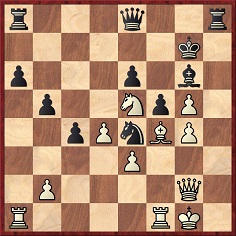
29 d5 exd5 30 Nxg6 Kxg6 31 gxf5+ Kxf5 32 Rad1 Rd8 33 g6 Qxg6 34 Bc7+ Resigns.
‘On 6 February 1920 Lasker gave a simultaneous exhibition in the club De Witte (The White) in The Hague. Two games appeared in Het Vaderland, 8 February 1920 (morning edition, page 3):’
L.A. Nijpels – Emanuel Lasker
The Hague, 6 February 1920
Albin Counter-Gambit
1 d4 d5 2 c4 e5 3 Nc3 exd4 4 Qxd4 Nc6 5 Qxd5 Be6 6 Qb5 Qd7 7 e3 Nb4 8 Qxd7+ Kxd7 9 Rb1 Nf6 10 a3
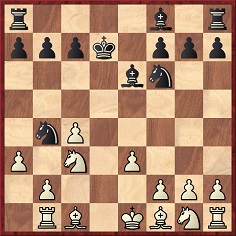
10...Nc2+ 11 Kd2 Bf5 12 Bd3 Bxd3 13 Kxd3 Ne1+ 14 Ke2 Nxg2 15 h4 Bd6 16 Kf1 Nxe3+ 17 Bxe3 Ng4 18 Rd1 Nxe3+ 19 fxe3 Kc6 20 Nge2 Rae8 21 Nd4+ Kc5 22 b4+ Kxc4 23 Ke2 Bf4 24 Nf5 Kxc3 25 Rd3+ Kb2 26 Rhd1 Be5 27 R1d2+ Kc1 28 Nd4 Bxd4 29 Rxd4 Re6 30 Rg4 Rc6 Drawn.
‘Since White could play 31 Rg1 mate, Black's 27th move may have been ...Kb1.’
H. Hakkert – Emanuel Lasker
The Hague, 6 February 1920
Ruy López
1 e4 e5 2 Nf3 Nc6 3 Bb5 Bc5 4 d3 Nge7 5 O–O O–O 6 Nc3 d6 7 h3 Be6 8 Be3 Bb6 9 Na4 h6 10 Nxb6 axb6
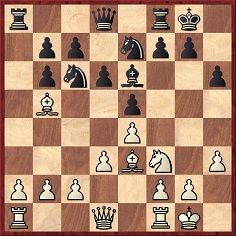
11 d4 f5 12 Bxc6 bxc6 13 dxe5 fxe4 14 exd6 exf3 15 dxe7 Qxe7 16 Qd4 Rad8 17 Qe5 Rd5 18 Qg3 Rh5 19 Qg6 fxg2 20 Qxh5 gxf1(Q)+ 21 Rxf1 Bd5 22 Qg4 Bf3 23 Qg3 Qe6 24 Bd4 Rf7 25 Kh2 Qd5 26 Bc3 Be4 27 Rg1 Qd7 Drawn.
‘The latter game was also in the above-mentioned article in De Telegraaf, 7 February 1920, which had the next one too:’
Emanuel Lasker – J.M.W. Nash
The Hague, 6 February 1920
French Defence
1 d4 e6 2 e4 d5 3 Nc3 Nf6 4 Bg5 Bb4 5 e5 h6 6 Be3 Ne4 7 Qg4 g5 8 h4 Rg8 9 Ne2 Rg7
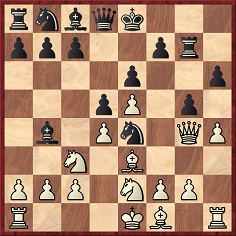
10 hxg5 hxg5 11 Rh8+ Bf8 12 Nxe4 dxe4 13 Ng3 Nd7 14 Nxe4 Qe7 15 O–O–O b6 16 Bb5 Bb7 17 Nf6+ Kd8 18 Bxd7 Resigns.
‘Lasker gave a display in the ASC (Amsterdamsche Schaakclub) on 9 February 1920. The following game was published in De Telegraaf, 13 February 1920 (evening edition, page 10). The event was not mentioned there, but can be identified from a list of players and results in the Haagsche Courant, 13 February 1920.’
Emanuel Lasker – Hendrik Gerhardus Reeders
Amsterdam, 9 February 1920
Ruy López
1 e4 e5 2 Nf3 Nc6 3 Bb5 a6 4 Ba4 Nf6 5 O–O Nxe4 6 d4 b5 7 Bb3 d5 8 dxe5 Be6 9 c3 Be7 10 Nbd2 O–O 11 Bc2 f5 12 Nb3 Qd7 13 Nbd4 Nxd4 14 Nxd4 c6 15 f3 Ng5 16 Qd3 c5 17 Bxg5 Bxg5 18 Nxe6 Qxe6 19 f4 Be7
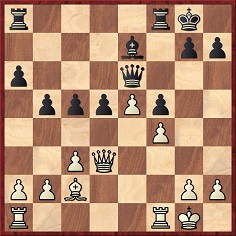
20 g4 g6 21 gxf5 gxf5 22 Kh1 Kh8 23 Rg1 Rad8 24 Rg2 d4 25 cxd4 Rxd4 26 Qf3 Rdd8 27 Rag1 Rg8 28 Rxg8+ Rxg8 29 Rxg8+ Kxg8 30 Qd3 Qc6+ 31 Kg1 c4 32 Qg3+ Kh8 33 Bxf5 Bc5+ 34 Kf1 Qh1+ 35 Ke2 Qc1 36 Kf3 Qd1+ 37 Kg2 Qe2+ 38 Kh3 Qh5+ Drawn.
‘Another game from this event was published in Algemeen Handelsblad, 6 March 1920 (evening edition, page 9):’
Emanuel Lasker – C. Keyzer
Amsterdam, 9 February 1920
Sicilian Defence
1 e4 c5 2 Nf3 Nc6 3 d4 cxd4 4 Nxd4 Nf6 5 Nc3 d6 6 Bc4 Bd7 7 O–O g6 8 Nxc6 Bxc6 9 Be3 Bg7 10 f3 O–O 11 Qd2 Qc7 12 Nb5 Qd7 13 Nd4 Rac8 14 Bb3 Bb5 15 Nxb5 Qxb5 16 Rfd1 Rc7 17 Qf2 b6 18 a4 Qc6 19 a5 Nd7 20 c3 Rb8 21 axb6 Nxb6 22 Ra3 Rcb7 23 Rd2
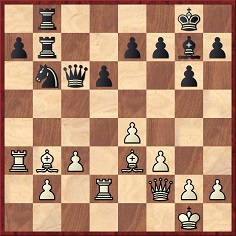
23...Nc4 24 Bxc4 Qxc4 25 h3 a6 26 Bd4 Bh6 27 Re2 Qd3 28 Ra1 Rb3 29 f4 Bxf4 30 Rf1 e5 31 Be3 Rxb2 32 Rxb2 Rxb2 33 Qxb2 Bxe3+ 34 Rf2 Qxe4 35 Kf1 Bxf2 36 Kxf2 Qc6 and Black won.
‘The next day, 10 February 1920, Lasker gave a display at the students’ chess club Philidor in Amsterdam. The game below was published in De Telegraaf, 13 February 1920 (the same edition and page number as given above) and Algemeen Handelsblad, 13 March 1920 (evening edition, page 9).’
Emanuel Lasker – P. Dijkstra
Amsterdam, 10 February 1920
Centre Counter Game
1 e4 d5 2 exd5 Qxd5 3 Nc3 Qa5 4 Nf3 Nf6 5 Be2 Nc6 6 O–O Bg4 7 d4 O–O–O 8 Be3 e5 9 Nb5 Bxf3 10 gxf3 a6 11 a4 exd4 12 Bf4 Nd5 13 Bg3 Qb4 14 Qd3 h5 15 c3 Qe7 16 Rfe1 Qf6 17 Nxd4 h4 18 Nxc6 hxg3 19 fxg3 Qxc6 20 Bf1 Bc5+ 21 Kh1 Ne3 22 Qe2

22...Nc2 23 Qxc2 Qxf3+ 24 Qg2 Rxh2+ 25 Kxh2 Rh8+ 26 Qh3+ Rxh3+ 27 Bxh3+ Kb8 28 Rf1 Bf2 29 Rg1 Bxg1+ 30 Rxg1 Qe2+ 31 Rg2 Qc4 32 a5 Qc5 33 Rd2 Qxa5 34 Kg2 f5 35 Kf3 Qe5 36 Re2 Qd5+ 37 Kf2 g5 38 Bg2 Qc5+ 39 Kf1 c6 40 Rf2 Qe3 41 Kg1 Qxg3 42 Rxf5 Qe3+ 43 Kh2 Qd2 44 White resigns.
‘Lasker gave an exhibition in Nijmegen on 11 February 1920, winning 27 games, drawing one and losing one, to H.G. Deckers (Provinciale Geldersche en Nijmeegsche courant, 12 February 1920). The defeat was published in De Telegraaf, 21 February 1920 (evening edition, page 7).’
H.G. Deckers – Emanuel Lasker
Nijmegen, 11 February 1920
Two Knights’ Defence
1 e4 e5 2 Nf3 Nc6 3 Bc4 Nf6 4 Ng5 d5 5 exd5 Na5 6 Bb5+ c6 7 dxc6 bxc6 8 Be2 h6 9 Nf3 e4 10 Ne5 Bd6 11 d4 Qc7 12 f4 exf3 13 Nxf3 Ng4 14 O–O Bxh2+ 15 Kh1 Bg3 16 Qd3 O–O 17 Qc3 Re8 18 Bd3 Nb7 19 Na3 Nd6 20 Nc4
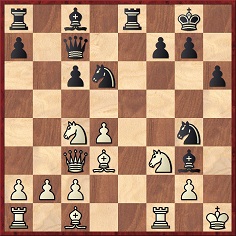
20...Nf2+ 21 Rxf2 Bxf2 22 Bf4 Bg4 23 Bxd6 Qd7 24 Nce5 Qxd6 25 Nxg4 Bg3 26 Rf1 Rad8 27 Nfe5 Qxd4 28 Qb3 Bxe5 29 Nxh6+ Resigns.
‘On 13 February 1920 Lasker was again in The Hague in the chess club DD (Discendo Discimus), where the tour had begun. This time he played simultaneously against five pairs of consulting players. All the games were published in De Telegraaf, 15 February 1920 (morning edition, page 10), and four are republished below (the fifth one, against van Gelder and H. Hakkert, having been given by Whyld).’
Emanuel Lasker – Jan Willem te Kolsté and J.
Vijzelaar
The Hague, 13 February 1920
Ruy López
1 e4 e5 2 Nf3 Nc6 3 Bb5 a6 4 Ba4 Nf6 5 O–O Nxe4 6 d4 b5 7 Bb3 d5 8 dxe5 Be6 9 c3 Be7 10 Nbd2 Nc5 11 Bc2 O–O 12 Nb3 Nxb3 13 axb3 Qd7 14 Re1 Rfd8 15 Bg5 Bf5 16 Bxf5 Qxf5 17 Bxe7 Nxe7 18 Nd4 Qg6 19 b4 Nf5 20 f4 Qb6
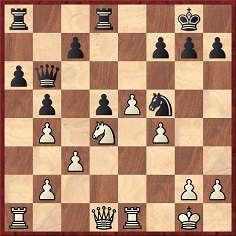
21 g4 Ne7 22 f5 c5 23 bxc5 Qxc5 24 f6 gxf6 25 exf6 Nc6 26 Qd2 Kh8 27 Kh1 Nxd4 28 cxd4 Qd6 29 g5 Re8 30 Rxe8+ Rxe8 31 Re1 Rxe1+ 32 Qxe1 Qb8 33 Qe7 Qc8 34 Qc5 Qe8 35 Qxd5 Qe1+ 36 Kg2 Qe2+ 37 Kg3 Qe3+ Drawn.
Rudolf Johannes Loman and Gerardus Wilhelmus
Johannes Zittersteyn – Emanuel Lasker
The Hague, 13 February 1920
Ruy López
1 e4 e5 2 Nf3 Nc6 3 Bb5 a6 4 Ba4 Nf6 5 O–O Be7 6 d4 exd4 7 e5 Ne4 8 Nxd4 O–O 9 Bxc6 dxc6 10 Be3 f6 11 exf6 Bxf6 12 c3 Qd5 13 Nd2 Nd6 14 Qb3 Qxb3 15 axb3 c5 16 Ne2 b6 17 Ng3 Be6 18 Rfe1 Bf7 19 Bf4 Rfe8 20 Nge4 Be7 21 f3 a5 22 Nxd6 Bxd6 23 Bxd6 cxd6
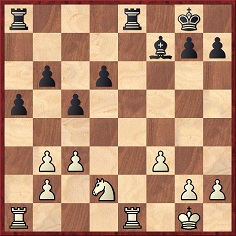
24 Nc4 Bxc4 25 bxc4 Rxe1+ 26 Rxe1 Kf7 27 Kf2 Rb8 28 Re2 b5 29 cxb5 Rxb5 30 Ke3 d5 31 Kd3 Rb7 32 Kc2 Re7 33 Rf2 a4 34 Kd2 Kf6 35 g3 Kf5 36 Re2 Rxe2+ 37 Kxe2 g5 38 Kd3 Ke5 39 Ke3 h5 40 Kd3 Drawn.
Emanuel Lasker – Gerard C. Adrianus Oskam and W.
van Kooy
The Hague, 13 February 1920
Ruy López
1 e4 e5 2 Nf3 Nc6 3 Bb5 Nf6 4 O–O Nxe4 5 d4 Be7 6 Qe2 Nd6 7 Bxc6 bxc6 8 dxe5 Nb7 9 Nc3 O–O 10 Nd4 Nc5 11 Rd1 Qe8 12 Re1 Ne6 13 Nxe6 fxe6 14 Be3 Rf5 15 f4 d5 16 Qf2 Qf8
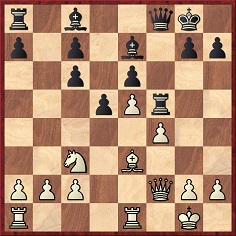
17 Na4 d4 18 Bxd4 Rxf4 19 Qd2 c5 20 Rf1 Rxf1+ 21 Rxf1 Qd8 22 Nxc5 h6 23 Rd1 Qd5 24 Qc3 Bxc5 25 Qxc5 Bb7 26 Qxd5 exd5 27 e6 Re8 28 Re1 Bc8 29 e7 Kf7 30 Bc5 a6 31 Kf2 Bf5 32 Re2 Bd7 33 Ke3 Rb8 34 b3 Bb5 35 Rf2+ Ke6 36 Rf8 Re8 37 Kd4 Bc6 38 a4 Bd7 39 Kc3 Bc6 40 Kb4 Kd7 41 Ka5 Ra8 42 Rxa8 Bxa8 43 Kxa6 Resigns.
Emanuel Lasker – J.F. Heemskerk and H. Steffelaar
The Hague, 13 February 1920
Queen’s Gambit Declined
1 d4 d5 2 Nf3 Bf5 3 c4 e6 4 Nc3 Nf6 5 cxd5 exd5 6 Qb3 Bc8 7 Bg5 Be7 8 Bxf6 Bxf6 9 Qxd5 O–O 10 e3 Qe7 11 Bd3 c6 12 Qe4 g6 13 Qxe7 Bxe7 14 Bc4 Kg7 15 O–O Nd7 16 Bb3 Nb6 17 h3 Bd7 18 Ne5 Rad8 19 Rfd1 Bc8 20 Rac1 f6 21 Nd3 Rd7 22 Ne4 Nd5 23 Nec5 Rd6 24 e4 Nc7

25 d5 b6 26 e5 fxe5 27 Ne4 c5 28 Nxe5 Rf5 29 Nxd6 Bxd6 30 Nc4 Bf4 31 Ne3 Rf6 32 Rc4 Nb5 33 Re4 Kf8 34 Nc4 Nd4 35 Rde1 Bd7 36 Re7 Bf5 37 Rxa7 g5 38 Bd1 b5 39 Bh5 Bg6 40 Bxg6 Rxg6 41 Ne5 Rd6 42 Nd7+ Resigns.
‘Another five-game simultaneous exhibition was given by Lasker on 16 February 1920, in the ASC. Again, only four of them are republished here, because the game against M. Euwe and C. Keijzer/Keyzer is in Emanuel Lasker Denker Weltenbürger Schachweltmeister edited by R. Forster, S. Hansen and M. Negele (Berlin, 2009). That book also has a game by Lasker against Euwe from a standard display. The first three games below are taken from De Telegraaf, 19 February 1920 (morning issue, page 2), and the fourth game was published in Algemeen Handelsblad, 20 March 1920 (evening edition, page 9).’
H. van Hartingsvelt and Hendrik Gerhardus Reeders –
Emanuel Lasker
Amsterdam, 16 February 1920
Two Knights’ Defence
1 e4 e5 2 Nf3 Nc6 3 Bc4 Nf6 4 d3 Bc5 5 Nc3 d6 6 Bg5 h6 7 Bxf6 Qxf6 8 h3 Ne7 9 Qd2 c6 10 a3 Bb6 11 O–O–O Be6 12 Bxe6 fxe6 13 d4 exd4 14 Nxd4 O–O–O 15 f3 Rhe8 16 Rhe1 Ng6 17 Nde2 e5 18 Kb1 Nh4 19 Nc1 g5 20 Na4 Bc7 21 c4 Ng6 22 Ne2 Kb8 23 Qc2 h5 24 Rd3 Nf4 25 Nxf4 gxf4 26 Red1 b6 27 Nc3 Rg8 28 b4 Qe6 29 Na4 a6 30 c5 dxc5 31 Rxd8+ Rxd8 32 Rxd8+ Bxd8 33 Qd3 Bc7 34 bxc5 b5 35 Nb2 Kb7 36 Qc3 Qg8 37 Qc2 a5 38 Nd3 Ka6
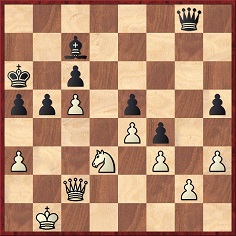
39 a4 Qd8 40 Qc3 bxa4 41 Kc2 Qg8 42 Ne1 Kb5 43 Qb2+ Qb3+ 44 Qxb3+ axb3+ 45 Kxb3 Kxc5 46 Nc2 Bd6 47 Ka4 Kc4 48 Na1 Bb4 49 Nb3 c5 50 Nc1 Kc3 51 g4 fxg3 52 Ne2+ Kb2 53 Nxg3 c4 54 Nxh5 c3 55 Ng3 c2 56 Ne2 c1(Q) 57 Nxc1 Kxc1 58 h4 Bd2 and White resigned after a few more moves.
Emanuel Lasker – E. Straat and P. Wiersma
Amsterdam, 16 February 1920
Queen’s Gambit Declined
1 d4 d5 2 Nf3 Nf6 3 c4 e6 4 Bg5 h6 5 Bh4 dxc4 6 e3 Bb4+ 7 Nbd2 b5 8 Be2 Bb7 9 O–O Nbd7 10 Qc2 a6 11 Rad1 Qc8 12 Bxf6 Nxf6 13 Nxc4 O–O 14 Nce5 Bd6 15 Rc1 Nd7 16 Nc6 Qe8 17 Na5 Bd5 18 e4 Bb4 19 Nc6 Bxc6 20 Qxc6 Ba5 21 a4 bxa4 22 Bxa6 Nf6 23 Bb7 Qxc6 24 Bxc6 Rab8 25 Rc2 Rb4
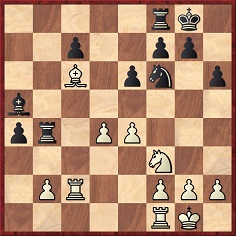
26 e5 Nd5 27 Rc5 Bb6 28 Rb5 Rc4 29 Bxd5 exd5 30 Rxd5 Rb4 31 Ra1 Rxb2 32 h4 Ra8 33 Ra3 Kf8 34 e6 fxe6 35 Re5 c5 36 dxc5 Rb1+ 37 Ne1 Bxc5 38 Rxc5 Rxe1+ 39 Kh2 Re4 40 g3 Rb4 41 Rc7 Rb3 42 Rxb3 axb3 43 Rb7 Ra2 44 Kg2 Rb2 45 Kf3 Rb1 46 Kg4 b2 47 Kh5 g5 Drawn.
Emanuel Lasker – Gerard Kroone and J.H. Löhr
Amsterdam, 16 February 1920
King’s Gambit Accepted
1 e4 e5 2 f4 exf4 3 Nf3 Nf6 4 e5 Nh5 5 d4 d5 6 Be2 g6 7 O–O c5 8 Ne1 Nc6 9 Bxh5 gxh5 10 Bxf4 Bg4 11 Qd2 Rg8 12 c3 Rc8 13 Be3 cxd4 14 cxd4 Qd7 15 Nc3 Ne7 16 Nd3 Ng6 17 Rac1 Rc6 18 Kh1 h4 19 Nf2 h3 20 Nxg4 Qxg4 21 gxh3 Qxh3 22 Qf2 f6 23 Nxd5 Nh4
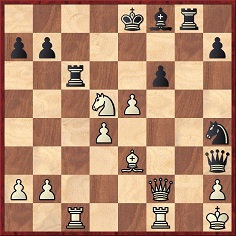
24 Rxc6 Rg2 25 Rc8+ Kd7 26 Rc7+ Resigns.
Jos. de Koning and W. Fok – Emanuel Lasker
Amsterdam, 16 February 1920
English Opening
1 c4 e5 2 Nc3 Nc6 3 g3 f5 4 Bg2 Nf6 5 d3 Bc5 6 Bg5 Bxf2+ 7 Kd2 Bb6 8 e3 d6 9 Nge2 Be6 10 Bd5 Bxd5 11 cxd5 Ne7 12 Bxf6 gxf6 13 Qa4+ Qd7 14 Qh4 O–O 15 d4 Kh8 16 Rhg1 Rae8 17 Raf1 c6 18 dxc6 bxc6 19 Qh3 Qe6 20 b3

20...c5 21 d5 Nxd5 22 Qxf5 Nxe3 23 Kxe3 c4+ 24 Kd2 Bxg1 25 Qxe6 Rxe6 26 Rxg1 cxb3 27 axb3 d5 28 Rf1 Rd8 29 Ra1 a6 30 Ra4 Red6 31 g4 h5 32 h3 hxg4 33 hxg4 Kg7 34 Ng3 Kg6 35 Nf5 R6d7 36 Rxa6 Kg5 37 Ra5 Kf4 38 Kd3 d4 39 Ne4 Rb7 40 Nc5 Rb6 41 Ra4 Kxg4 42 Ke4 d3 43 Ne3+ Kg5 44 Nxd3 Rxb3 45 Nc5 Rb6 46 Nd3 Rb5 47 Ne1 Kg6 48 Nf3 Rdb8 49 Nh4+ Kf7 50 Nhf5 Rb4+ 51 Rxb4 Rxb4+ 52 Kd5
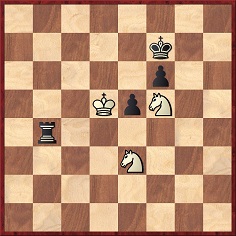
52...Rb1 53 Kd6 Ra1 54 Kd5 Ra8 55 Nd6+ Ke7 Drawn. (Adjourned and adjudicated by H. Weenink)
‘A simultaneous display in Utrecht was given by Lasker on 20 February 1920. The following two games were published in De Telegraaf, 21 February 1920 (evening edition, page 7 – as above), and the event is identifiable on account of a short report in Algemeen Handelsblad of the same day (evening edition, page 10).’
Emanuel Lasker – G.Ch. Smeekes
Utrecht, 20 February 1920
Queen’s Gambit Declined
1 d4 d5 2 c4 e6 3 Nf3 Nf6 4 Bg5 Nbd7 5 e3 Be7 6 Nc3 O–O 7 Rc1 b6 8 cxd5 exd5 9 Bd3 Bb7 10 O–O c5 11 Ne5 h6 12 Bh4 Re8 13 f4 Ne4 14 Bxe7 Rxe7 15 Nxe4 Nxe5 16 dxe5 dxe4 17 Bc4 Qc7 18 Qb3 Rd8 19 Rcd1 Rxd1 20 Rxd1 Bc8
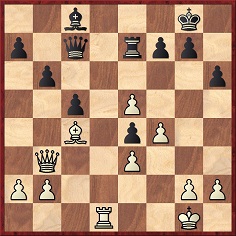
21 Rd6 Rd7 22 Qd1 Rxd6 23 Qxd6 Qxd6 24 exd6 Kf8 25 Bd5 f5 26 Bc6 Be6 27 a3 Kf7 28 g4 g6 29 Kf2 Bc4 30 gxf5 gxf5 31 Bd7 Be6 Drawn.
Emanuel Lasker – P. Ponssen
Utrecht, 20 February 1920
Queen’s Gambit Declined
1 d4 d5 2 c4 c6 3 e3 Nf6 4 Nc3 Bf5 5 cxd5 cxd5 6 Qb3 Bc8 7 Nf3 a6 8 Bd2 e6 9 Rc1 Bd6 10 Bd3 O–O 11 O–O Nc6 12 e4 dxe4 13 Nxe4 Be7 14 Bc3 Nd5 15 Rfe1 Nxc3 16 bxc3 b5 17 Qc2 g6 18 a4 b4 19 Red1 Rb8 20 Bc4 Na5 21 Bd3 b3 22 Qb2 Qb6 23 Ne5 Qc7 24 c4 f5 25 Ng3 Bf6 26 f4
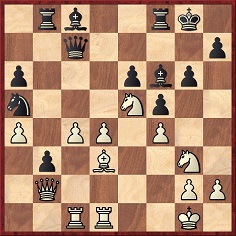
26...Rb4 27 d5 Qc5+ 28 Kh1 Bxe5 29 Qxe5 Nxc4 30 Bxc4 Rxc4 31 Rb1 exd5 32 Rxb3 Rxa4 33 h4 Ra2 34 Rbd3 Bb7 35 h5 Qf2 36 Rg1 d4 37 Qe6+ Kg7 38 Qe7+ Rf7 39 h6+ Kg8 Drawn.
‘The following game was published with the two previous ones, and since Lasker’s opponent was from Utrecht it may be from the same display.’
Emanuel Lasker – J.H. Goud
The Netherlands, January or February 1920
King’s Gambit Accepted
1 e4 e5 2 f4 exf4 3 Nf3 g5 4 Bc4 Bg7 5 d4 h6 6 c3 d6 7 O–O c6 8 Qb3 Qe7 9 Nbd2 Nd7 10 a4 Nb6 11 Bd3 Be6 12 Qc2 a5 13 b3 Qc7 14 Bb2 Ne7 15 c4 Bg4 16 d5 Bxb2 17 Qxb2 O–O–O 18 b4 Nd7 19 Rfc1 axb4 20 Qxb4 Nc5 21 Bc2 Na6 22 Qb2 c5 23 Ne1 Ng6 24 a5 Ne5 25 Nd3 f6 26 Qc3 Kb8 27 Ba4 Rhf8 28 Bb5 Nxd3 29 Qxd3 Nb4 30 Qb3 Ka7 31 Nb1 Qe7 32 Nc3 h5
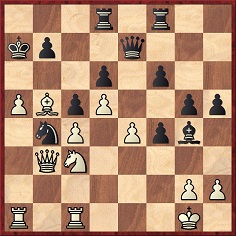
33 a6 b6 34 Bc6 Nxc6 35 dxc6 Be6 36 Nb5+ Ka8 37 Rd1 Rh8 38 Rab1 Bg4 39 Re1 Rc8 40 c7 Be6 41 Qd3 Rxc7 42 Nxc7+ Qxc7 43 Red1 Rd8 44 Qc3 Ka7 45 Qxf6 Bxc4 46 Qxg5 f3 47 Qf4 fxg2 48 Rd2 Bxa6 49 Ra1 Ra8 50 Rda2 Kb7 51 Qf5 c4 52 Qd5+ Qc6 53 Qxc6+ Kxc6 54 Rxa6 Rxa6 55 Rxa6 Kb5 56 Ra8 c3 57 Kxg2 Kb4 58 Kf2 c2 59 Rc8 Kb3 60 Ke2 Resigns.
‘A game definitely played in Utrecht is the next one, whose finish was published in De Telegraaf, 21 February 1920 (morning edition, page 7):’
Emanuel Lasker – Schuckink Kool and G.A.W. Verzijl
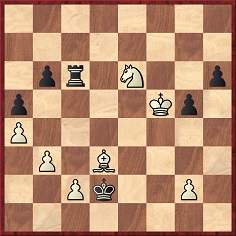
1 Be4 Rxc2 2 Bxc2 Kxc2 3 Nc7 Kxb3 4 Nd5 Kxa4 5 Nxb6+ Kb5 6 Nd5 Kc4 7 Nb6+ Kd4 Drawn.
‘On 24 February 1920 Lasker gave an exhibition in the chess club in Zeist (Algemeen Handelsblad, 25 February 1920, morning edition, page 8), and the latter part of a game was published in the Nieuwe Rotterdamsche Courant, 26 February 1920 (evening edition, page 1):’
Emanuel Lasker – A.S. Katan
Zeist, 24 February 1920
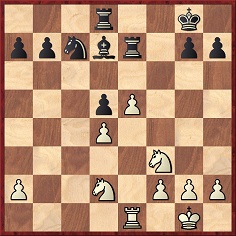
23 Nb3 Bc6 24 Nfd2 Ne6 25 h4 Rf8 26 g3 h5 27 f4 Nxf4 28 gxf4 Rxf4 29 Kg2 Rxh4 30 Nf3 Rg4+ 31 Kf2 Bd7 32 Rh1 Rf4 33 Kg3 Ref7 34 Nbd2 Bg4 35 Ng5 Rxd4 36 Nxf7 Rxd2 37 Ng5 Rxa2 38 Rc1 Re2 39 Kf4 d4 40 Rc7 d3 41 Rxb7 g6 42 Rb8+ Kg7 43 Rb7+ Kf8 44 Nh7+ Ke8 45 Nf6+ Kd8 46 Nxg4 d2 47 White resigns.
‘Lasker gave another display in The Hague on 26 February 1920, this time in the Residentie chess club. Three games were published in Het Vaderland the next day (evening edition, unnumbered page):’
Emanuel Lasker – Jan Willem te Kolsté
The Hague, 26 February 1920
Ruy López
1 e4 e5 2 Nf3 Nc6 3 Bb5 a6 4 Bxc6 dxc6 5 Nc3 Bc5 6 d3 Qd6 7 Be3 Bg4 8 h3 Be6 9 d4 exd4 10 Bxd4 Bxd4 11 Qxd4 Nf6 12 O–O–O Qf4+ 13 Kb1 O–O 14 Rd3 b6 15 g3 Qh6 16 Qe3 Qxe3 17 Rxe3 Rad8 18 g4 Rfe8 19 Kc1 Bc8 20 Rd1 Bb7 21 Rxd8 Rxd8 22 Rd3 Rxd3 23 cxd3
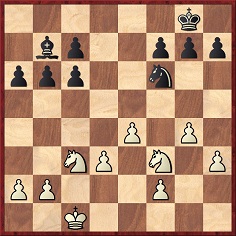
23...c5 24 Kd2 h6 25 Ke3 Kf8 26 Nh4 g6 27 f4 Ke7 28 Ne2 c4 29 Ng3 cxd3 30 Kxd3 c5 Drawn.
Emanuel Lasker – W. de Bruijn
The Hague, 26 February 1920
Queen’s Gambit Declined
1 d4 d5 2 c4 e6 3 Nf3 Nf6 4 Bg5 Nbd7 5 e3 Be7 6 Nc3 O–O 7 Rc1 c5 8 cxd5 cxd4 9 Nxd4 Nxd5 10 Bxe7 Nxe7 11 Be2 Nf6 12 Bf3 Ned5 13 O–O Nxc3 14 Rxc3 e5 15 Nb5 a6 16 Nc7 Rb8 17 Qb3 e4 18 Be2 b5 19 Qb4 Nd5 20 Nxd5 Qxd5
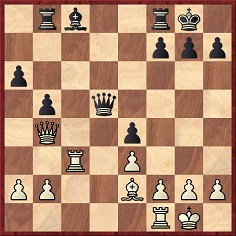
21 a4 Qd2 22 Bc4 Bd7 23 axb5 Bxb5 24 Bxb5 Rxb5 25 Qxe4 Rxb2 26 Qd3 g6 27 Qxd2 Rxd2 28 Ra3 Ra8 Drawn. ‘White’s 28th move is taken from De Telegraaf, 5 March 1920.’
Emanuel Lasker – R.D.G. Telkamp
The Hague, 26 February 1920
Ruy López
1 e4 e5 2 Nf3 Nc6 3 Bb5 d6 4 d4 Bd7 5 Nc3 Nf6 6 O–O Be7 7 Bg5 O–O 8 Qd3 a6 9 Bxc6 Bxc6 10 dxe5 dxe5 11 Nxe5 Re8 12 Nxc6 bxc6 13 Bf4 Qb8 14 b3 Bb4 15 f3 Rd8 16 Qe3 Ba5 17 Na4
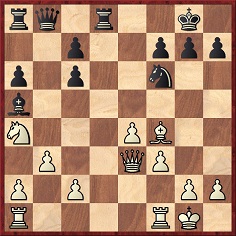
17...Bd2 18 Qxd2 Rxd2 19 Bxd2 Qa7+ 20 Rf2 Rd8 21 Kf1 Nd7 22 Re1 Qb7 23 Be3 Ne5 24 Nc5 Qb4 25 a4 a5 26 Rfe2 Drawn.
‘There are also games whose exact occasion cannot be specified:’
R.A.J. Meijer – Emanuel Lasker
The Netherlands, January or February 1920
Queen’s Pawn Opening
1 d4 Nf6 2 Nf3 e6 3 c4 b6 4 d5 Bb7 5 Nc3 Bb4 6 Bg5 h6 7 Bxf6 Qxf6 8 Qb3 Na6 9 O–O–O Bxc3 10 Qxc3 Qxc3+ 11 bxc3 Nc5 12 Rd4 Ke7 13 Nd2 e5 14 Rg4 Rag8 15 e4 d6 16 h4 Bc8 17 Rg3 g6 18 Re3 f5 19 f3 f4 20 Re1 Bd7 21 Nb3 Na4 22 Kd2 g5 23 Nc1 g4 24 Be2 Rg7 25 Kc2
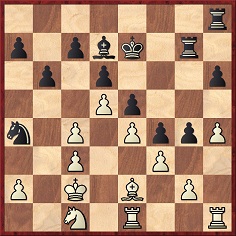
25...Rhg8 26 Nd3 Kf6 27 Ref1 Nc5 28 Ne1 gxf3 29 Bxf3 b5 30 cxb5 Bxb5 31 Rf2 Rb8 32 Rd2 Rb6 33 g4 fxg3 34 Ng2 Rg8 35 Ne3 Ba4+ 36 Kc1
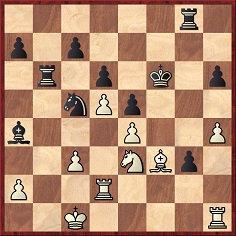
36...Rgb8 37 White resigns.
‘It is known that Meijer lost to Lasker in Nijmegen on 11 February 1920, but this game had already been published in De Telegraaf, 7 February 1920 (evening edition, page 6 – as above). That is also the source for the next game:’
Willem Andreas Theodorus Schelfhout – Emanuel
Lasker
The Netherlands, January or February 1920
Vienna Gambit
1 e4 e5 2 Nc3 Nf6 3 f4 d5 4 fxe5 Nxe4 5 Nf3 Nc6 6 Bb5 Be7 7 O–O O–O 8 Qe2 Nc5 9 d4 Ne6 10 Be3 f6 11 Rad1 a6 12 Ba4 Na5 13 Bb3 Nxb3 14 axb3 c6 15 Qf2 fxe5 16 dxe5 Bd7
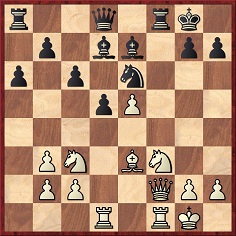
17 Bb6 Qxb6 18 Qxb6 Bc5+ 19 Qxc5 Nxc5 20 b4 Ne6 21 Na4 Rad8 22 c3 Be8 23 Nd4 Rxf1+ 24 Rxf1 Nxd4 25 cxd4 Rd7 26 Nc5 Re7 27 h3 Bg6 28 Rf4 Bc2 29 g4 b6 30 Nxa6 Bd3 31 Nb8 Bb5 32 e6 Rxe6 33 Nd7 g5 34 Rf5 Re1+ 35 Kg2 h6 36 Rf6 Kg7 37 Rd6 Re2+ 38 Kf3 Rxb2 39 Nxb6 Rxb4 40 Nc8 Rxd4 41 Ne7 Rd3+ 42 Kg2 c5 43 Nf5+ Kf8 44 Rxh6 Rd2+ 45 Kg3 Bd3 46 Rh8+ Kf7 47 Rh7+ Ke6 48 Rh6+ Ke5 49 Rg6 c4 50 Rxg5 c3 51 White resigns.
‘It is known that Schelfhout lost to Lasker in Enschede on 29 January 1920 (Provinciale Overijsselsche en Zwolsche courant, 2 February 1920), but it is unclear whether this was the game.
The final game was published in De Telegraaf, 13 February 1920 (same edition and page as above).’
Emanuel Lasker – M.L.
The Netherlands, January or February 1920
French Defence
1 e4 e6 2 d4 d5 3 Nc3 Nf6 4 Bg5 Be7 5 e5 Nfd7 6 h4 a6 7 Qg4 h5 8 Bxe7 hxg4 9 Bxd8 Kxd8 10 Nd1 f6 11 exf6 gxf6 12 Ne3 f5 13 Ne2 Nf6 14 g3 Bd7 15 Bg2 Nc6 16 O–O–O b5 17 Nf4 Ne7 18 Rhe1 Ne8 19 c4 c6 20 b3 bxc4 21 bxc4 Ng7 22 Kb2 Kc7 23 Kc3 Rab8 24 Rb1 dxc4 25 Nxc4 Nd5+ 26 Bxd5 cxd5 27 Ne5 Bb5 28 Nf7 Rhc8 29 Kd2 Be8
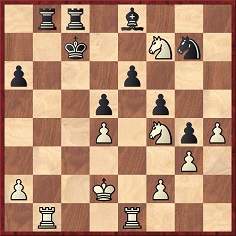
30 Ng5 Rxb1 31 Rxb1 Kd6 32 Rb7 Bd7 33 Ra7 Rc6 34 Nf7+ Ke7 35 Ne5 Rd6 36 h5 Ne8 37 Nfg6+ Kf6 38 Nxd7+ Kg5 39 Nf4 Resigns.
| First column | << previous | Archives [153] | next >> | Current column |
Copyright: Edward Winter. All rights reserved.